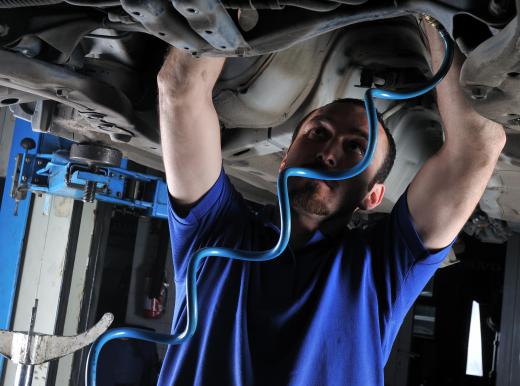An impact wrench is tool used to tighten or loosen a screw or bolt using pressure from a hammer, which is converted into a twisting motion inside the tool. It can be manually operated, or it can be powered by electricity or compressed air. One powered by an air compressor is also known as a pneumatic wrench.
This works in the manner suggested by its name: through the principle of impact. A manually powered impact wrench looks like a fat screwdriver; on the end where the screwdriver blade normally goes, the operator can snap on screwdriver bits or sockets. The bit or socket is fit onto the screw or bolt, and then the operator hits the other end with a hammer while holding the wrench down. The inner workings of the wrench transform the downward impact into a turning motion, and the bolt is gradually loosened. This type of wrench works great, if a bit slowly, for breaking stiff or unyielding bolts loose.

An electrical or air-powered impact wrench works much the same way: when the operator pulls the trigger, impact from tiny hammers inside the wrench is transformed into a rotary motion. The difference between one of these power tools and a manually powered wrench is that the tool does the work for the user, and very quickly in comparison to the manual wrench.
Impact wrenches are often misused by those who don’t know about their special needs. First of all, it is very important for the user to be careful when tightening a nut or bolt with one. Cross threading can occur very easily; a novice may also over-torque a bolt or a nut if he or she don’t know when to stop. To prevent such problems, the user must always be sure to hand-tighten every nut or bolt before using the impact wrench; if he or she tries to start the nut or bolt with the wrench, it won’t be possible to feel if the threads are crossed. If the wrench is not torque controlled — meaning it will stop when the nut or bolt is tightened to a certain torque — the operator will need to go slowly, and periodically check the torque value of the nut or bolt to make sure he or she hasn't tightened it too far.
An impact wrench also requires a few special accessories. An air-powered model runs off of an air compressor with a tank; the air compressor should have at least a 10 gallon (45.4 liter) tank and be able to generate at least 3hp. Also, this type of wrench requires special sockets that are designed to withstand the high torque applied by the tool.
Although using an impact wrench requires a certain degree of expertise, it certainly makes the job easier by cutting down on the amount of work and time required. This tool can even make changing a flat tire easier: some manufacturers make portable wrenches that plug into the cigarette lighter of a car and come with a variety of sockets to fit any size lug nut.
